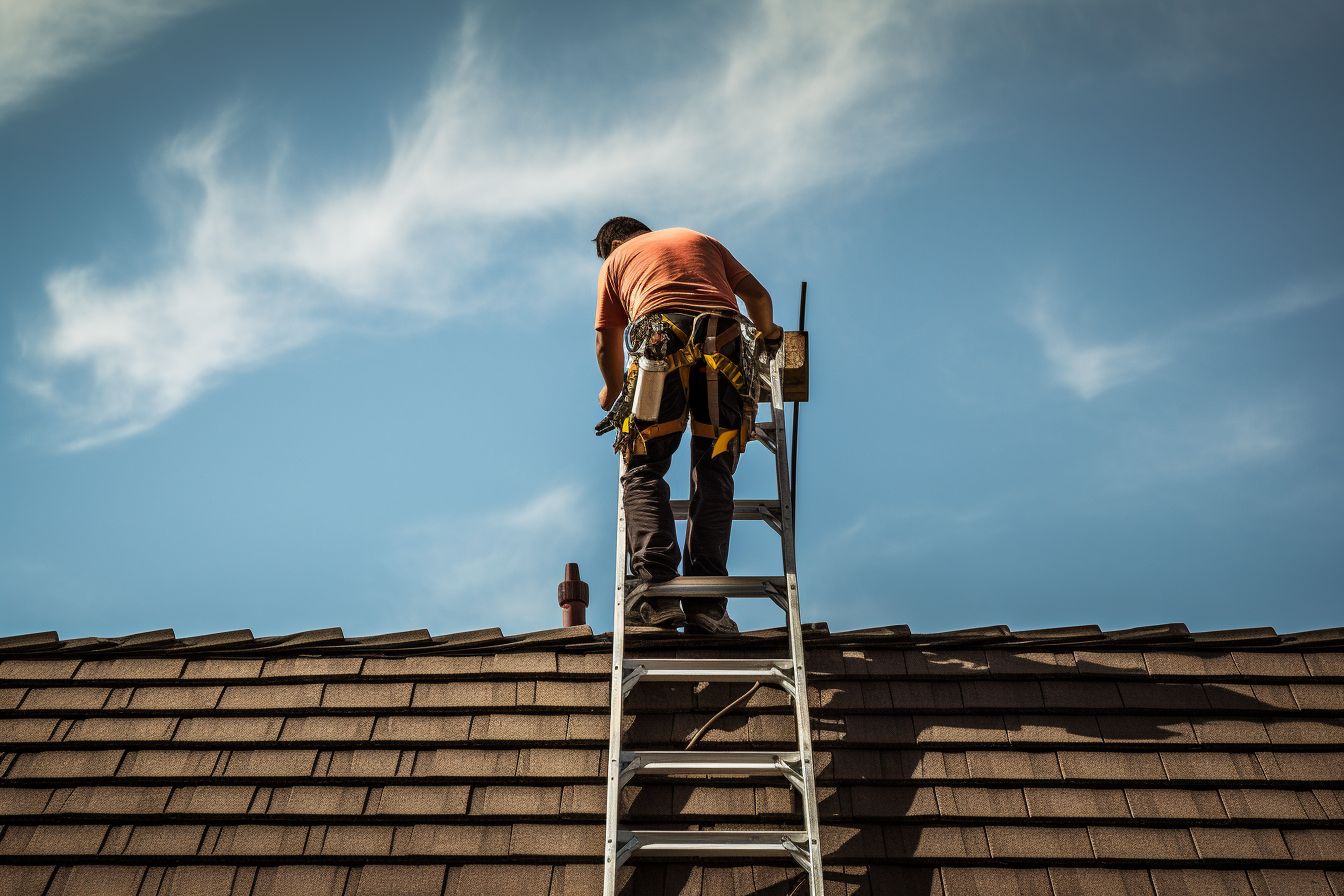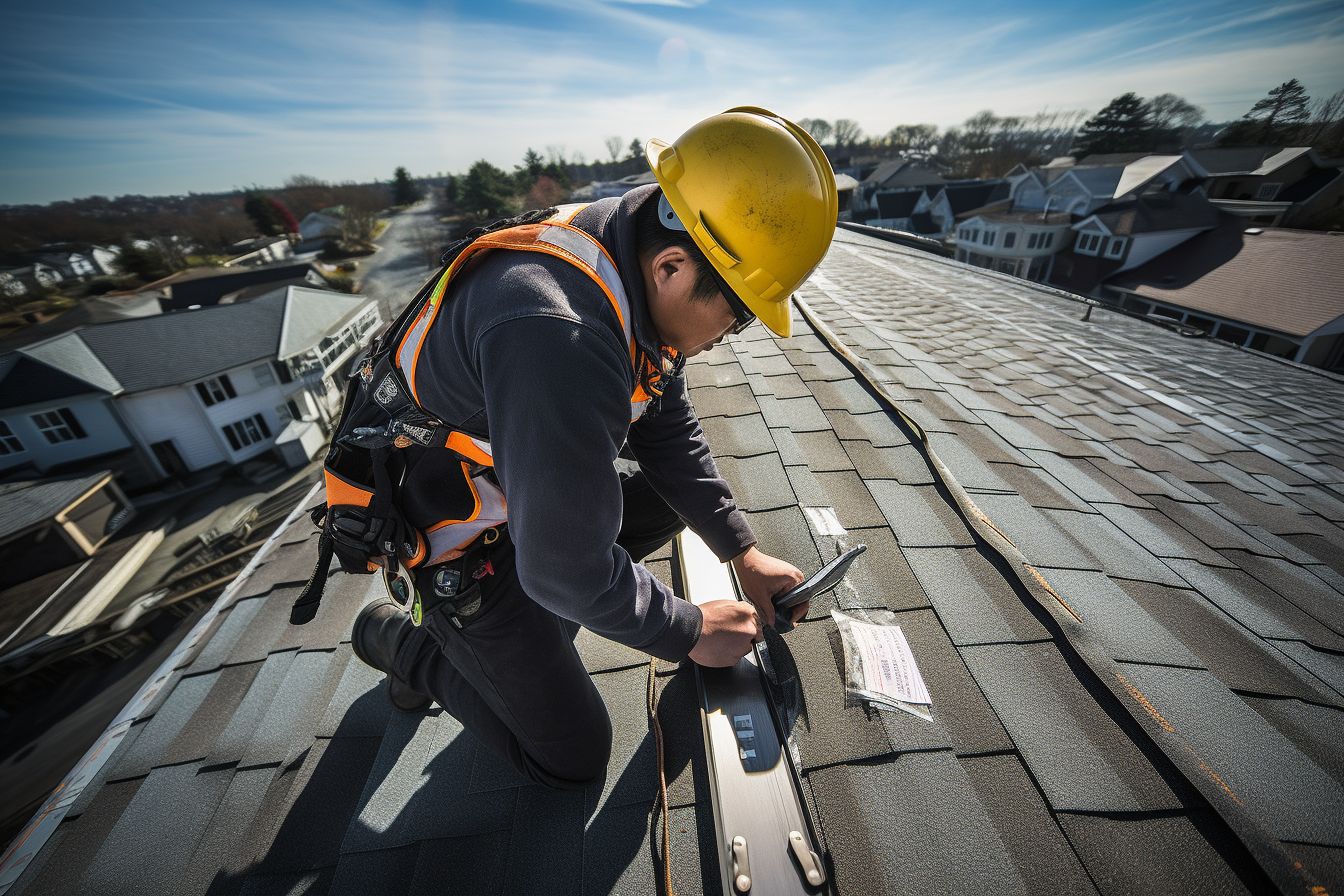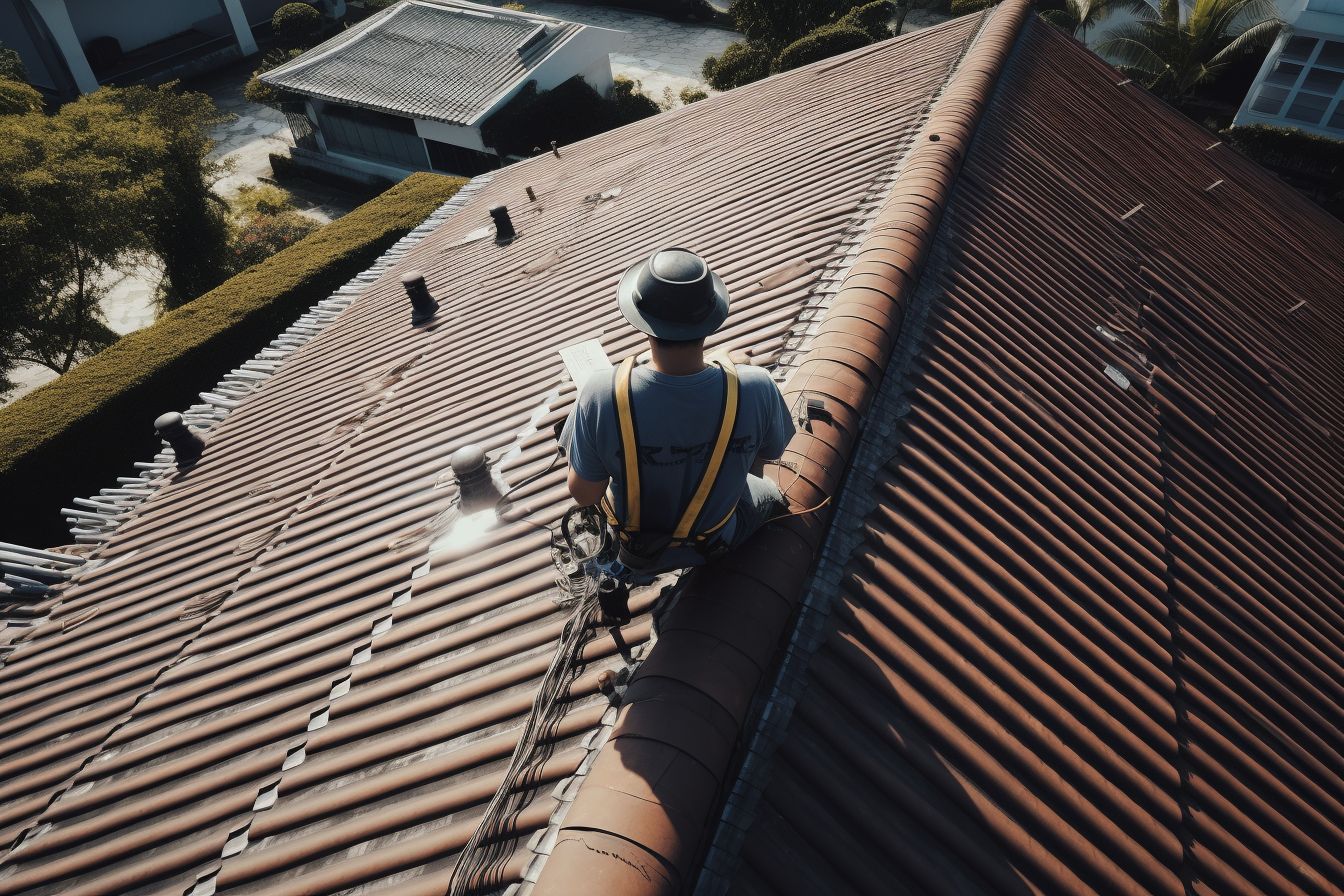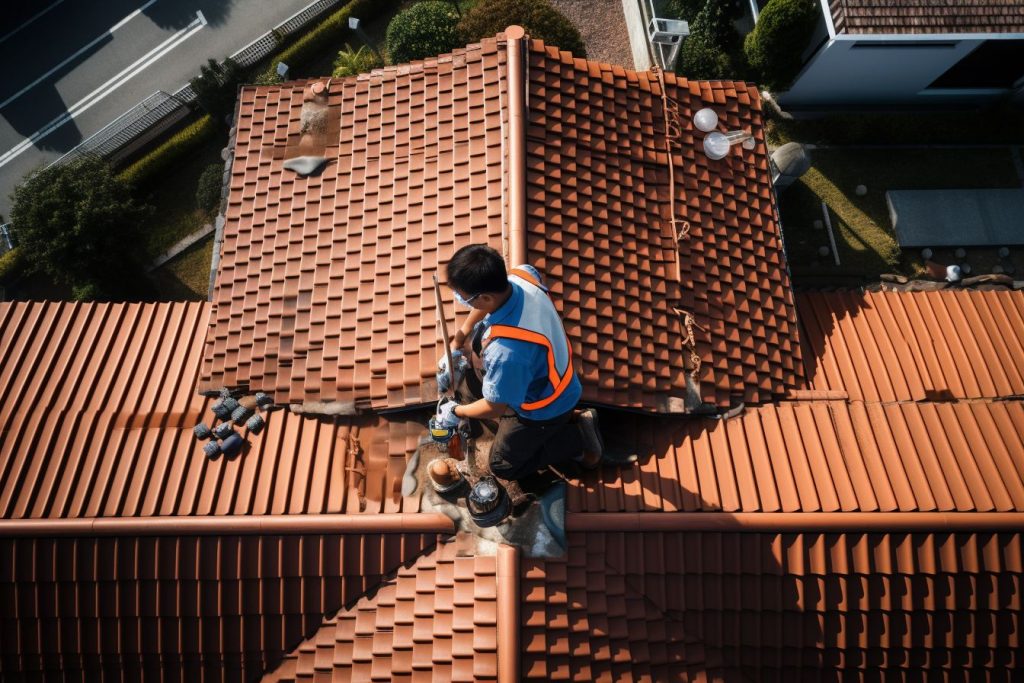Measuring a roof can feel overwhelming if you’re unfamiliar with the process. However, accurate measurements are crucial for estimating roofing costs and ensuring proper installation or repair.
This article will provide straightforward instructions on measuring your roof accurately, breaking down complex calculations into easy-to-understand steps. Ready? Let’s demystify the world of roofing measurements!
Key Takeaways
- Familiarise yourself with different types of roofs, gather the necessary tools, and prioritise safety precautions before measuring a roof.
- Start by taking measurements from the ground using a tape measure, digital tools, or apps designed for roof measurement.
- Create a detailed diagram of the roof’s layout to visualise its dimensions and shape accurately.
- Calculate the roof square footage by multiplying the length and width of each section and dividing it by 100 to determine the number of squares required for your project.
What You Should Know Before Measuring a Roof

Before measuring a roof, it is important to familiarise yourself with different types of roofs, gather the necessary tools, and prioritise safety precautions.
Different Types of Roofs
Flat roofs, gable roofs, hip roofs and mansard roofs are common roofing structures. Flat roofs have no slope and can be easy to measure but tricky to maintain because water does not run off easily.
Gable roofs form a triangle shape with two sides sloping downwards from a central ridge, providing excellent drainage in rainy weather. Hip roofs have four sloped sides that meet at the top for increased stability but require more complex measurements due to their shape.
Mansard roofs boast dual slopes on each side for maximised living space underneath but can pose a challenge when estimating shingle quantity due to the varied pitch on one side. Each type poses unique considerations you need to factor in during your re-roofing project.
Tools Needed
Before starting the task of measuring a roof, you need to gather all the necessary tools. Without the right gear, you run the risk of inaccurate measurements or, worse, safety issues. Here are the indispensable resources you require:
- A tape measure: This is essential for any measurement job.
- Ladder: To reach the roof safely.
- Safety Harness: Important for your safety while working on heights.
- Chalk or marker: To mark measurements directly on the roof.
- Notebook and Pen: To jot down all the measurements taken.
- Calculator: Handy for doing quick calculations on site.
- A clinometer or Pitch Gauge: Vital devices used to determine roof pitch factor.
- Digital Camera: Useful to click pictures if needed for reference later on.
Safety Advice
Safety is a top priority when measuring roofs, requiring specific precautions and equipment. Hazards should be promptly identified by employers to ensure the safety of workers during roof repair jobs.
Adequate training is integral to rooftop safety measures as it equips individuals with techniques to stay protected while on duty. Regular team communication also plays a crucial role in maintaining a secure environment.
Employing physical barriers serves as vital rooftop safety measures, creating safer working zones for those involved in roof work. Additional support from specialised equipment aids in preventing potential risks and accidents that may occur without appropriate precautions.
Further protection can be offered through commercial roofing safety procedures, ensuring everyone’s well-being while performing the task.
Steps for Measuring a Roof

To measure a roof, start by taking measurements from the ground and diagramming the roof to visualise its shape.
Taking measurements from the ground
Begin by ensuring you have all your roof measurement tools at hand. Select a convenient spot to conduct your ground-level roof measurements, then measure the length and width of each surface area on the roof using Google Earth or satellite imagery for roof measurement if necessary.
This method safely provides accurate roof measurements, eliminating the risks of climbing onto roofs. To ensure accuracy, consider utilising available Android or iPhone apps specifically designed for this purpose–roof measuring apps offer both convenience and precision.
Use these measurements with a roof measurement calculator to determine the exact dimensions of your asphalt shingle or any other type of roof.
Diagramming the roof
Creating a roof diagram requires precision and attention to detail. As part of the steps for measuring a roof, sketching out the structure’s layout aids in better visualising its dimensions and shape.
A careful approach ensures accurate measurements critical for successful roof projects.
Starting with your collected data, outline the rooftop on graph paper or any other suitable medium. Label each section clearly with their respective measurements taken during your hands-on analysis.
Your finished roof diagram serves as a scaled blueprint, presenting potential contractors with clear expectations and instructions for the proposed roof development. This step-by-step procedure guarantees that every aspect of your roof construction will adapt precisely to the actual conditions met on site.
Estimating Roof Measurements from the Ground
Calculate the roof square footage by multiplying the length and width of each section. Determine the roof pitch factor using a roofing calculator or manual calculation, then calculate the number of roof squares based on this factor.
Calculating roof square footage
Begin by sketching the roof’s different planes and noting down the measurements of each section. Remembering that a complex roof may have varied shapes like rectangles, squares, or triangles is crucial.
Measure these areas separately for accuracy in the roof square footage calculation.
Next, calculate the area of every plane by using basic geometry formulas: length x width for rectangles and 0.5 x base x height for triangles. If you are dealing with irregular shapes like trapezoids or circles, use their respective formulas.
Once all areas are calculated individually, add them together to determine the total square footage of your roof. This method can be applied universally no matter what roofing materials you’re working with – tiles, shingles or metal roofing.
Roof squares come into play when purchasing your roofing materials since one “square” covers 100 sq ft. Divide your square footage by 100 to determine how many squares you need for your project.
For convenience and a speedier estimation process, online tools such as a Roof Square Calculator can assist you through this process step-by-step by entering a few parameters from roof measurement data collected on-site.
Determining roof pitch factor
Understanding the roof pitch factor is crucial to accurately estimating your roof measurements from the ground. Begin by determining your roof’s angle, incline or slant, as these factors significantly impact the calculation.
The process involves expressing the roof slope and pitch as vertical to horizontal measurements proportions. To find this ratio, you use what’s known as a pitch multiplier applied to your length and width dimensions.
This calculated value aids in accurately gauging material needs for roofing projects. Meticulous attention to detail during this step ensures an accurate result, benefiting subsequent stages like calculating roof squares or considering repair requirements.
Calculating roof squares
Calculating roof squares is a crucial step in accurately estimating the size of your roof. To determine the number of squares on your roof, you must divide all planes’ total square footage by 100.
This measurement method helps roofing professionals understand and calculate the needed materials. It’s essential to be as precise as possible when measuring the area of your roof, as even small errors can lead to costly mistakes.
Fortunately, online tools can assist you in calculating roof square footage quickly and easily. So, use these resources to ensure accurate measurements for your roofing project.
Measuring Roof from the Top of the Structure
Once you have safely reached the top, you can begin taking initial measurements of your roof – find out how to accurately measure and calculate the area in our comprehensive guide on roof repair.
Getting up safely and taking initial measurements
To measure a roof accurately, it’s important to start by getting up safely and taking initial measurements. Before climbing onto the roof, wear safety gear, such as non-slip shoes and harnesses.
Use a sturdy ladder with someone holding it steady for added stability. Once on the roof, take note of any obstacles or potential hazards that may affect your measurements. Begin by measuring the length and width of each roof section using a tape measure or laser distance measure.
This will give you an idea of the overall size of the roof before moving on to more detailed measurements.
Splitting tricky shapes
Splitting tricky shapes is essential when measuring a roof from the top of the structure. Sometimes, roofs have complex shapes, making it difficult to get precise measurements.
You can ensure accurate square footage calculations and roof pitch by dividing these shapes into squares and rectangles. This is crucial for adequately estimating materials and costs for a re-roofing project and ensuring the success of your overall roofing plans.
Drawing shapes and calculating the area
Drawing shapes and calculating the area is crucial to measuring a roof accurately. This involves determining the shapes that make up the roof, such as rectangles, triangles, or trapezoids, and then calculating their respective areas.
The total area of all these shapes will give you the overall square footage of the roof. Knowing the roof’s area allows you to estimate important factors like shingle quantity and roof replacement cost.
To simplify this process, online tools can assist with calculating complex geometric shapes and their corresponding areas.
Comprehensive Guide on Roof Repair

Repairing a roof can be daunting, but with the comprehensive guide on roof repair provided by Roof Repair, you’ll have all the information you need to tackle the job successfully.
This guide covers everything from roofing maintenance and restoration to waterproofing and insulation. Whether you’re dealing with damaged shingles, faulty flashing, clogged gutters, or leaking skylights, this guide covers you.
One of the critical aspects of roof repair is identifying and addressing any issues with ventilation and eaves. Proper ventilation helps prevent moisture buildup and extends the lifespan of your roof.
The guide provides detailed instructions on how to assess your current ventilation system and make any necessary improvements. Additionally, it offers tips for maintaining clear eaves to ensure efficient water runoff.
With this comprehensive guide, you can confidently tackle any roof repair project. Explore Roof Repair’s website for step-by-step tutorials, expert advice, and product recommendations to help you achieve a long-lasting solution to your roofing problems.
Conclusion
In conclusion, measuring a roof accurately is essential for estimating costs and planning roofing projects. By following the step-by-step guide in this article, you can easily determine your roof’s square footage and pitch.
Remember to use accurate measurements and the tools and apps available to simplify the process. With this simple guide, you can measure your roof like a pro and ensure accurate estimates for your roofing needs.
FAQs
1. What tools do I need to measure a roof?
To measure a roof, you will need a tape measure, a ladder or scaffolding for access, and possibly binoculars if the measurements require viewing distant roof sections.
2. How do I calculate the square footage of my roof?
To calculate the square footage of your roof, measure the length and width of each section, multiply them together to get the area in square feet, and then add all the areas together.
3. Can I measure my roof from the ground?
While it’s possible to estimate certain measurements from the ground using tools like binoculars or smartphone apps, it is generally recommended to access and walk on your roof for accurate measurements physically.
4. What are some common mistakes to avoid when measuring a roof?
Common mistakes include not accounting for overhangs, incorrectly measuring slopes or angles, forgetting to convert units (e.g., feet to inches), and inaccurately recording measurements due to human error.
5. Should I hire a professional roofer to measure my roof?
For complex roofs or if you’re unsure about measurement accuracy, hiring a professional roofer with accurate measurement experience is wise and can provide an expert assessment.

